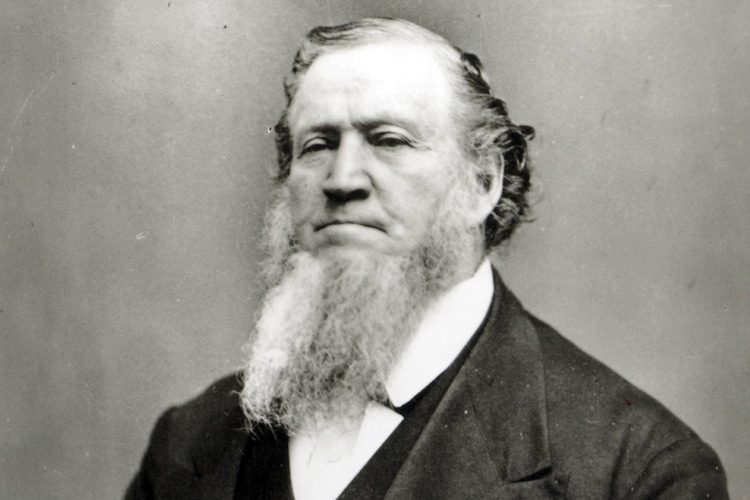St. George • Try as they might, leaders of The Church of Jesus Christ of Latter-day Saints in southern Utah had a difficult time weaning members off wine in the late 1800s and early 1900s.
That’s one major takeaway from Dennis R. Lancaster, whose research into the then-named Dixie Wine Mission, which cropped up more than 150 years ago in what is today Washington County, was featured in a recent Salt Lake Tribune article.
Tasked by Brigham Young with growing grapes to make wine for the church sacrament, or Communion — at this point in the faith’s history, drinking alcohol was not strictly forbidden for members — early settlers’ spirited attempts in southern Utah to comply with their pioneer-prophet’s directive came with an unfortunate byproduct: alcoholism.
Indeed, some farmers’ fervor for making the fruit of the vine was matched or exceeded only by the amount they consumed. Soon problem drinking and public intoxication became widespread.
Even so, attempts by Young and regional church leaders to slow the flow of wine consumption by members and their leaders met with little success – especially when that message was mixed.

(Tribune file photo) Brigham Young, second president of The Church of Jesus Christ of Latter-day Saints, grew concerned about problem drinking rooted in the wine mission.
In “Dixie Wine,” a thesis Lancaster published in 1972 while pursuing a master’s degree at Brigham Young University, he recounts the story of Angus Cannon asking Young if it was wrong for a tipsy church elder to assist with the religious practice of laying on of hands to heal the sick.
When asked to whom he was referring, Cannon told Young that he had asked “Brother Haskell” to assist him and he detected a strong wine odor on his breath.
“To this,” Lancaster wrote, “President Young replied, ‘Brother Cannon, do you know I would rather be administered upon by Brother Haskell drunk than by many of our elders sober.’”
Young people in the church also took to drink with an almost missionary zeal. Lancaster quotes from an account given by Reed W. Farnsworth in “Wine Making in Southern Utah” about two young Toquerville men who sat in the front row at church meetings.
“As soon as they had been served [the sacramental wine] they would immediately get up and move back four rows, repeating this process until they had participated in about four servings of the sacrament,” Lancaster wrote. “After this, it is said that the fervor with which they bore their testimonies was unusually convincing.”
Francisco Kjolseth | The Salt Lake Tribune
Indeed, wine and alcohol consumption became a staple at church events as well as at weddings dances and parties. In his thesis, Lancaster relates prominent Utah historian Karl Larson’s account of playing trombone at a dance in Leeds.
When it was time for intermission, the band members went outside for some fresh air and were offered wine to drink by a group of dancers. The drummer, in particular, guzzled “more than enough to make him feel good.”
“When we got back in there and started playing,” Lancaster quotes Larson as saying, “man, was he hammering those drums. When asked where he got all those notes, the drummer replied, ‘There should be one line of music here I’m supposed to play, but I can see three and I’m playing them all.’”
Given the copious amount of wine consumption, when area church leaders supplanted wine with water for the sacrament in 1892 and made the faith’s Word of Wisdom health code barring alcohol use more binding, many Latter-day Saints, young and older, had trouble toeing the teetotaler line.
The church, for example, still stored barrels of wine in the cellar of the Toquerville tithing office as late as the early 1900s. Lancaster relates Bob Naegle’s account of he and other boys breaking out a window in the tithing office in 1907. The older boys formed a human chain and lowered Naegle and a friend named Dewey, who were the smallest of the group, to the floor, where they could stick a hose in the barrels and siphon the wine into a gallon jug.
Trouble was, Dewey sucked at siphoning.
“So I gave a big suck on it and got a mouthful of two or three swallows,” Naegle told Lancaster in an interview. “We filled four or five jugs that way and then we pulled the hose out and put the cork back in. The boys [then] reached down to pull us out. They got Dewey out, but I was just dizzy as could be. So when I finally got out, I could hardly walk.”
Naegle’s ambulatory woes were further exacerbated, Lancaster noted, when he was caught by his mother and given a good paddling.
(The Church of Jesus Christ of Latter-day Saints) The St. George Temple, released Wednesday, Sept. 5, 2023.
Read more here about the church’s wine mission in southern Utah, including how a bottle of wine wound up in the cornerstone of the faith’s St. George Temple (which has been renovated and recently reopened for public tours) and how the potent potions the locals made and drank boosted attendance at Latter-day Saint meetings and stoked more visions and prophecies and — problem drinking.









